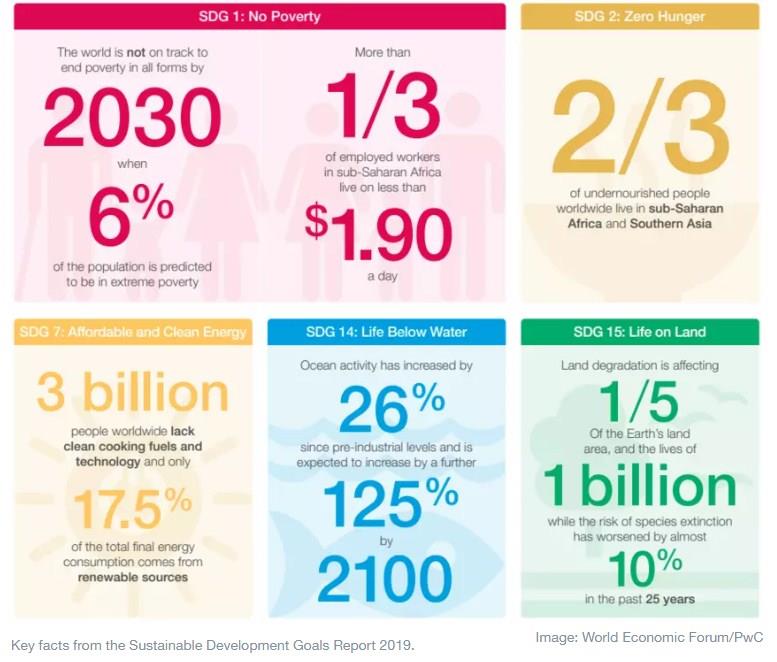by Celine Herweijer and Antonia Gawel*
We’re currently tackling the biggest global public health crisis in a century. We will need to act decisively and rapidly if we are to address this crisis head on and rebuild and reconfigure our economies and societies for a prosperous, inclusive and sustainable future.
The Sustainable Development Goals (SDGs or Global Goals) offer a clear direction, yet our ability to meet the 2030 deadline for the UN’s 17 Global Goals was off track at the beginning of 2020, and the COVID-19 pandemic has only exacerbated many of the challenges we face, e.g. from UN-reported increases in malaria deaths (Goal 3), to school closures and the lack of digital connectivity for billions (Goal 4), or the outsized impact on vulnerable populations (Goal 10).
In January at Davos 2020, the World Economic Forum and PwC published research which underscored the enormous potential of technology to advance progress towards the Global Goals. Since then, COVID-19 has dramatically accelerated the role of technology in our everyday lives, from remote working and education, to telehealth, online shopping, and increased automation of routine manufacturing and back office tasks.
As the power and pervasiveness of technology grows, there is a growing – and increasingly urgent – need to steer its use to service the positive societal and economic objectives that underpin Global Goals. Technology has the potential to enable a more sustainable post-pandemic global future, if deployed thoughtfully and strategically. Strong leadership will be essential in order to drive these desirable outcomes.

In recognition of the crucial need for strong leadership in this space over the coming decade, we have developed a guiding framework to support corporate leaders in making informed decisions about how to use new technologies to deliver broader societal impact, including reaching our Global Goals.
The framework provides an approach to enable companies to scale efforts on responsible tech, or “tech for good”, beyond pilots and into mainstream business activity. It’s about harnessing technology-driven business transformation to create better solutions, industries and markets for people and our planet.
The guiding framework, when adopted, embeds a responsible technology approach across an enterprise – from strategy, operating model and supply chain, to governance and people – in order to scale action and bring it into the mainstream. To make the framework more tangible we have developed a set of guiding questions. These are the types of questions C-suite, and business function leaders, should be asking themselves, and addressing, as they seek to embed and integrate new technologies across their businesses and value chains to drive holistic commercial, environmental and social impact.
Below, we extract and explain three key questions from the framework, that corporate leaders should ask as they seek to rebuild and drive positive change in the world, in this case through the use of technology:
1. Have you clearly defined a commitment to harnessing technology to deliver progress towards the Global Goals, and leadership accountability for delivering your ambition?
Companies must first articulate a clear commitment to take action. This commitment should be communicated from the Board and senior executives in a way that resonates internally through the organization, as well as externally with a broad range of stakeholders. The Board should engage with, and hold itself accountable for, the company’s responsible use of technology and its commitment to use technology to create a more sustainable and accessible world. The Board should also assign Senior Management responsibility for delivering this ambition.
2. Have you considered how to embed responsible technology considerations into your company strategy and operating model?
Companies must integrate delivery of the Global Goals (and social and environmental impact more broadly) into their core strategies, and ensure that technology is embedded as a key driver and accelerant of change. This will require assessment of implications and implementation of targeted initiatives for the growth strategy and operating model, including key decision-making processes, core business functions, accountability frameworks, investment decisions, the allocation of finance and resources, and product and/or service delivery.
3. Do your corporate investment decisions around technology transformation, innovation and R&D, and product development focus on solving big societal challenges relevant to your industry and capability?
Investment decisions taken today will drive business and societal impacts over the course of future years and decades. This is particularly true of decisions made around long-term investments such as those in technology transformation, innovation and R&D, and product development. When undertaking decisions in any of these areas, companies should make socioeconomic and environmental impact a core consideration. This will help companies to create and use technology solutions that deliver meaningful progress towards the Global Goals.
If all corporate leaders were to ask themselves these questions (and the broader set outlined in the Guiding Framework) and were to follow that framework, the positive impact achieved within and across organizations would be significant. These actions would mitigate a range of technology-related risks and unintended consequences, while at the same time providing technology, resources and talent to tackle many of our shared global challenges. Overall, strong and collective leadership on harnessing technology to achieve the Global Goals would emphatically define a course for post-pandemic sustainable development that would benefit humanity for decades to come.
*Global Leader, Innovation& Sustainability, PwC and Head of Circular Economy & Innovation; Member of the Executive Committee, World Economic Forum
**first published in: www.weforum.org






